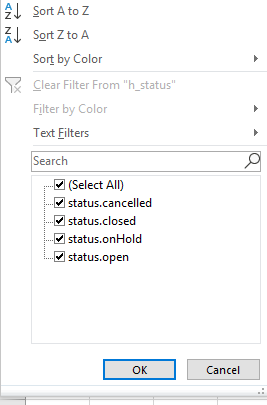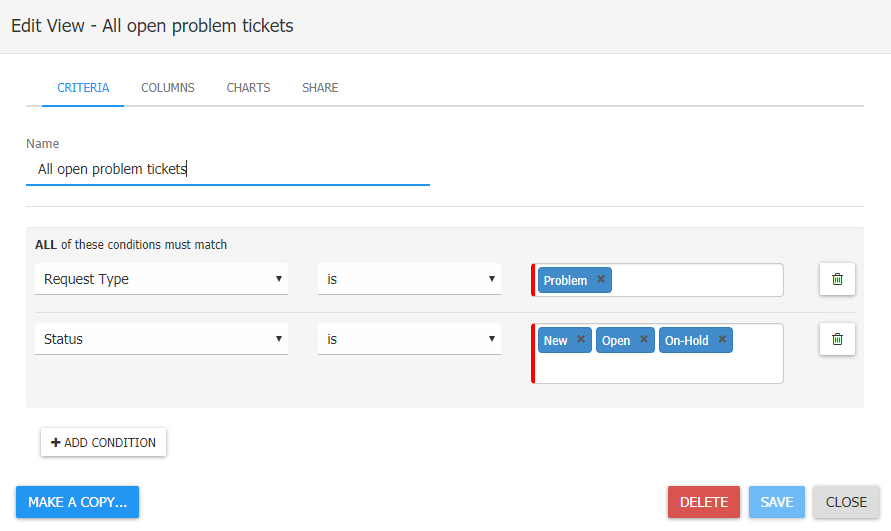
mikehibbert
Hornbill Users-
Posts
23 -
Joined
-
Last visited
Content Type
Profiles
Forums
Enhancement Requests
Everything posted by mikehibbert
-
It would be great if someone could review this - it's holding up a key piece of work for us in service manager.
-
Why do Services come before ticket type?
mikehibbert replied to mikehibbert's topic in Service Manager
Absolutely I take your point regarding HR and IT services requiring different questions. In this context I am talking purely about IT services. Perhaps what I deemed a workaround is a valid way of working after all in that case! -
Why do Services come before ticket type?
mikehibbert replied to mikehibbert's topic in Service Manager
Hi James, Sorry for taking a while to get back to you. Yes I was referring to the Service Portal. Apologies, I must have started typing ticket types and continued onto Problems without thinking! To me, it just feels a bit counter-intuitive. As a worked example, we are currently re-designing our Service Catalogue (in the ITIL sense of the word "service") and will probably end up with 15 - 20 services. For incidents, in particular, it seems inefficient to have 20 services displayed on the portal, with each one having an incident request catalogue entry underneath it. Wouldn't it be easier to have one big "Something's wrong, help!" button on the Service Portal and then as part of the BPM it is linked to the relevant service? As a workaround at the moment we have a "Whats not working?" service, which is then linked to the service that is impact. However, that in itself causes a bit of a reporting headache as some ticket types are logged directly against a service and others are linked to a service. Thanks, Mike -
Bumping this as I can't believe no-one else is doing or wants to do this?
-
With an ITSM tool, you would usually expect follow roughly this process to log a ticket; Choose whether you're logging an incident/change/problem/etc. Associate this ticket to the relevant service This means you have a homepage with perhaps a button for each ticket type. However, Hornbill seems to force you down this route to a log a ticket; Find which service you think might be affected by incident/change/problem/etc. Choose a request catalogue item within that service that is relevant depending whether it is an incident/change/problem/etc. The "Hornbill way" leads to a more cluttered first screen (you need to display all of your services) and seems at odds with other tools I have used. I was just wondering why this is and if there is any plan to change it?
-
Impact & Probability for problem tickets
mikehibbert replied to mikehibbert's topic in Service Manager
Would this be possible? -
+1
-
Is anyone else trying to do this, or has managed to achieve it?
-
Request list view not showing all requests
mikehibbert replied to mikehibbert's topic in Service Manager
Hi James, I did have access to that tool (didn't know it existed!) so I ran the following query; SELECT * FROM h_itsm_requests where h_requesttype='problem' I exported the results to Excel to check what statuses the problems had, but only the following showed, so I don't think the issue you've seen before is what's at play here? Cheers, Mike -
I have set up a view for problem tickets with the following criteria: However, out of 47 tickets, 3 do not appear in the view even though they adhere to the criteria. I only found out about them because a report with exactly the same criteria shows them. I can view the tickets so I don't think permissions are an issue. Can anyone figure out why this might be the case?
-
I want to gather the time spent on linked requests. For example, if a problem ticket as 10 linked incidents, I'd like to sum up the time spent on those 10 incidents for cost/benefit analysis of fixing a problem. I'm sure this was reported as an upcoming feature at Insights - does this feature exist or is it in development?
-
Just wanted to bump this in case anyone has any ideas...?
-
We have around 200 services in Hornbill Service Manager. The same problem management process is linked to all of them, but I want to change the request details form. Is there a way I can "bulk" update the request details form for all services? If that isn't an option, I may create a service specifically for problem management and link to the relevant service instead as it gives me more control. If I were to go for that option, is there a way I can "bulk" turn off the problem configuration for every service?
-
Assign Human Task to the Request Owner
mikehibbert replied to mikehibbert's topic in Service Manager
-
Impact & Probability for problem tickets
mikehibbert replied to mikehibbert's topic in Service Manager
I now have access! I've created an assessment, but it looks like the "Impact Level" is calculated by summing the value of the answers to the questions. Is it possible to choose to multiply values instead? In essence, I'm trying to get your traditional impact vs. probability matrix calculation into Hornbill. -
How can you assign a Human Task, within a BPM workflow, to the owner of the Request ticket?
-
Change process used by "Raise New" button
mikehibbert replied to mikehibbert's topic in Service Manager
Ahh.... the BPM process hadn't been published, causing the confusion Apologies!! -
Change process used by "Raise New" button
mikehibbert replied to mikehibbert's topic in Service Manager
I've just realised that this isn't working as you might expect. I've checked that "Service A" is using "BPM Process 1" (dummy example names here of course :-)) in the request config for problem tickets. I click Raise New > Problem and during the progressive capture choose "Service A", but it is not using "BPM Process 1". Is there somewhere the request config for a service is overridden? -
Change process used by "Raise New" button
mikehibbert replied to mikehibbert's topic in Service Manager
Apologies, yes I did mean progressive capture and you have answered my question perfectly thanks @Steven Boardman! -
How do you change the BPM process that the "Raise New" button uses in live.hornbill.com/* ?
-
I'd like to setup a way of automatically tracking the % of incidents caused by problems or known errors. By that I mean the percentage of incidents that have a related request that is a problem or known error on a monthly basis. I have created very basic measures, widgets and dashboards, but really don't have any idea how to get started on this! Can anyone point me in the right direction?
-
Impact & Probability for problem tickets
mikehibbert replied to mikehibbert's topic in Service Manager
Thanks for the detailed feedback, Steve. I don't seem to have access to that "Configuration" menu, so I'll speak to our admin internally and give it a go. -
Relatively new to Hornbill so go easy on me! I'd like to set up the functionality to record the impact and probability of a problem ticket in Hornbill, but can't figure out a way of doing it. If these could be numerical values that I could also perform calculations from for reports that would be even better! Can anyone point me in the right direction?



